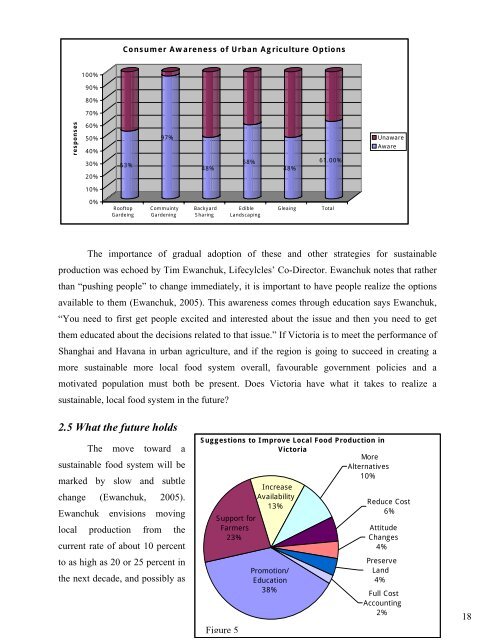Sustainable Food Production, Consumption, and the Generation of
Sustainable Food Production, Consumption, and the Generation of
Sustainable Food Production, Consumption, and the Generation of
Create successful ePaper yourself
Turn your PDF publications into a flip-book with our unique Google optimized e-Paper software.
esponses<br />
100%<br />
90%<br />
80%<br />
70%<br />
60%<br />
50%<br />
40%<br />
30%<br />
20%<br />
10%<br />
0%<br />
Consumer Awareness <strong>of</strong> Urban Agriculture Options<br />
53%<br />
Ro<strong>of</strong>top<br />
Gardeing<br />
97%<br />
Commuinty<br />
Gardening<br />
48%<br />
Backyard<br />
Sharing<br />
58%<br />
Edible<br />
L<strong>and</strong>scaping<br />
48%<br />
61.00%<br />
Gleaing Total<br />
Unaware<br />
The importance <strong>of</strong> gradual adoption <strong>of</strong> <strong>the</strong>se <strong>and</strong> o<strong>the</strong>r strategies for sustainable<br />
production was echoed by Tim Ewanchuk, Lifecylcles’ Co-Director. Ewanchuk notes that ra<strong>the</strong>r<br />
than “pushing people” to change immediately, it is important to have people realize <strong>the</strong> options<br />
available to <strong>the</strong>m (Ewanchuk, 2005). This awareness comes through education says Ewanchuk,<br />
“You need to first get people excited <strong>and</strong> interested about <strong>the</strong> issue <strong>and</strong> <strong>the</strong>n you need to get<br />
<strong>the</strong>m educated about <strong>the</strong> decisions related to that issue.” If Victoria is to meet <strong>the</strong> performance <strong>of</strong><br />
Shanghai <strong>and</strong> Havana in urban agriculture, <strong>and</strong> if <strong>the</strong> region is going to succeed in creating a<br />
more sustainable more local food system overall, favourable government policies <strong>and</strong> a<br />
motivated population must both be present. Does Victoria have what it takes to realize a<br />
sustainable, local food system in <strong>the</strong> future?<br />
2.5 What <strong>the</strong> future holds<br />
The move toward a<br />
sustainable food system will be<br />
marked by slow <strong>and</strong> subtle<br />
change (Ewanchuk, 2005).<br />
Ewanchuk envisions moving<br />
local production from <strong>the</strong><br />
current rate <strong>of</strong> about 10 percent<br />
to as high as 20 or 25 percent in<br />
<strong>the</strong> next decade, <strong>and</strong> possibly as<br />
Aware<br />
Suggestions to Improve Local <strong>Food</strong> <strong>Production</strong> in<br />
Victoria<br />
More<br />
Alternatives<br />
10%<br />
Increase<br />
Availability<br />
13%<br />
Support for<br />
Farmers<br />
23%<br />
Figure 5<br />
Promotion/<br />
Education<br />
38%<br />
Reduce Cost<br />
6%<br />
Attitude<br />
Changes<br />
4%<br />
Preserve<br />
L<strong>and</strong><br />
4%<br />
Full Cost<br />
Accounting<br />
2%<br />
18











